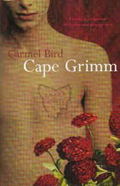 | Reviews of Cape Grimm by Carmel Bird. |
This book was originally published in 2004 and has been nominated for the 2006 IMPAC Dublin Literary Award.
Michelle Griffin in "The Age" profiles Carmel Bird rather than writing a review of the book. She does, however, provide a look behind the author's motivation for the book and sets the boosk in context: "Cape Grimm is the third book in a trilogy of novels Bird has written around the idea of charisma and evil. The first, The White Garden, was inspired by the experimental deep-sleep therapy practised at Chelmsford in the 1960s. The second, The Red Shoes, drew much of its framework from Anne Hamilton-Byrne's cult, The Family. Cape Grimm is set in a real landscape - a weather station in a remote corner of northwest Tasmania that measures the purest air currents in the world - but the story of an apocalyptic cult is only loosely inspired by historic events."
In the "Australian Book Review" James Ley describes the novel as "magic realism", along with stating that it doesn't fall victim to the florid excesses of that genre. "Its narrative explicity positions itself on the borderline between dream and reality, and there is a conflation of history and fantasy thoughout, as suggested by the title, which combines Tasmania's Cape Grim with the Brothers Grimm." There has certainly been a large amount of work undertaken by Bird to tackle some big ideas: "Cape Grimm explores ideas about the powers and responsibilities of the imagination. Culture, it suggests, has the ability to cross boundaries, influencing people's perceptions in unpredictable ways. Like a fable, the novel also has a cautionary aspect, suggesting that there are dangers in denying the creative impulses of the unconscious." In the end, though, it falls "into the magic realist trap of working both sides of the street at once:
admitting the unsupportable nature of many of its fantasies, but requiring they be accepted all the same".
In "The Bulletin" Anne Susskind is rather cautious in her conclusion: "Everywhere evident is Bird's fascination with the landscape of her native Tasmania, its lushness, its 4000 lakes and its isolation, particularly at Cape Grimm and the Baseline Air Pollution Station on the far north-western coast, where the air is as pure as anything in the world, sullied only by the fires her imagination dreams up. The tales of the Brothers Grimm, she writes in the persona of Van Loon, feed a 'need, a lust, a love in the world, a longing to be provided, fed, nourished with strange dark wild terrible images'. And so, successfully, does she. Although her story fizzes a bit towards the end, Bird shows here that she is a powerful and lyrical writer, and Cape Grimm makes compelling reading."
